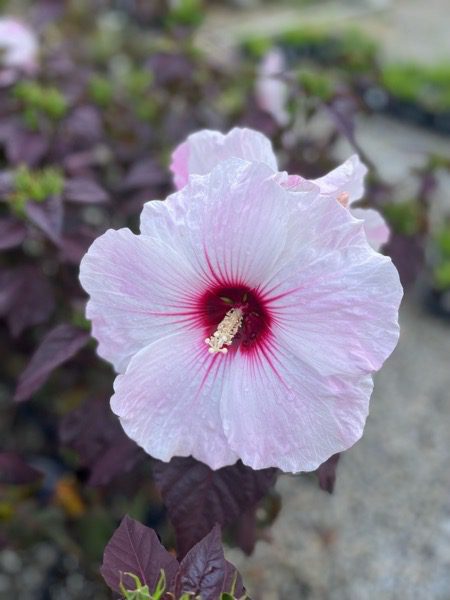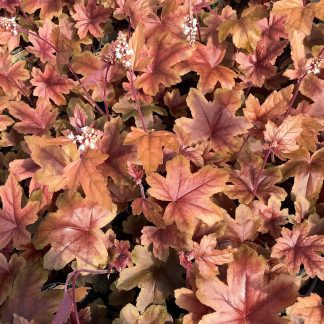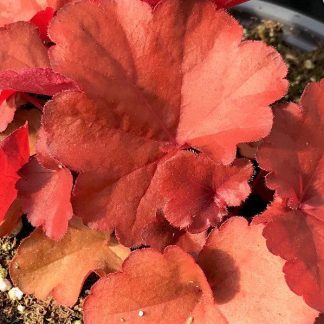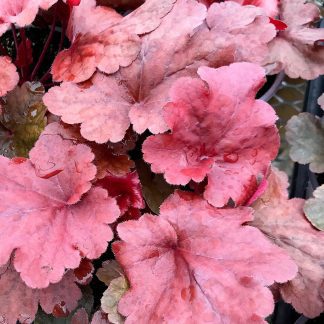Description
Hibiscus ‘Dark Mystery’: A Dramatic Showpiece for the Summer Garden
Hibiscus ‘Dark Mystery’ is a perennial hibiscus that demands attention. With nearly black foliage and enormous white flowers featuring a bold red eye, it creates a striking contrast few plants can match. It’s part of the Summerific® series, known for hardy hibiscus varieties that thrive in cold climates yet deliver tropical-scale blooms.
This article explores everything you need to know about Hibiscus ‘Dark Mystery.’ From its intense coloration to planting, care, and design tips, you’ll see why this hibiscus is a top choice for gardeners who want drama and elegance in one plant.
The Allure of Dark Foliage and Bright Blooms
Dark Mystery stands out immediately because of its foliage. The leaves are a deep burgundy, appearing almost black in strong sunlight. This dark background sets off the pure white blooms, each spanning up to nine inches across. At the center of every flower is a vivid red eye, radiating outward in striking contrast.
This bold combination looks sophisticated and modern, making it perfect for gardeners seeking a plant that doubles as a focal point. The contrast also allows Dark Mystery to shine in both colorful plantings and monochrome landscapes.
Growth Habit and Plant Size
Dark Mystery forms a sturdy, upright mound, typically reaching about four to five feet tall and spreading four to six feet wide. Its height makes it an excellent backdrop for shorter perennials and a standout feature in mixed borders.
Like other hardy hibiscus, it is slow to emerge in spring but grows rapidly once warm weather arrives. By midsummer, the plant is covered in buds, with blooms opening daily through late summer and early fall.
Choosing the Best Location
Sunlight is critical for Dark Mystery’s performance. Full sun — at least six hours daily — produces the best foliage color and the most abundant blooms. In partial shade, the plant will still flower but may lose some of its deep leaf coloration.
The soil should be rich, evenly moist, and well-drained. Hardy hibiscus love water but dislike standing water. Amending the planting site with compost or organic matter helps ensure both moisture retention and good drainage.
Plant in a spot with good airflow to reduce the risk of fungal issues during humid summers.
Planting Steps for Success
- Wait for warm weather – Plant in late spring or early summer after frost danger has passed.
- Prepare the soil – Loosen and enrich with compost to improve fertility and structure.
- Dig the right hole – Twice the width of the root ball, but only as deep.
- Set the plant – Position the root ball level with the soil surface.
- Backfill and firm – Refill the hole with soil, pressing gently to remove air pockets.
- Water thoroughly – Soak well after planting to help roots establish.
- Mulch generously – A two- to three-inch mulch layer conserves moisture and suppresses weeds.
Watering and Feeding
Dark Mystery thrives on consistent moisture. During hot summer months, water deeply two to three times a week. Avoid allowing the soil to dry out completely, as this can stress the plant and reduce flowering.
Fertilize in spring when new growth appears. A balanced fertilizer, or one slightly higher in potassium, encourages strong blooms and healthy foliage. Feed every four to six weeks during summer, then stop in late summer to allow the plant to prepare for winter dormancy.
Pruning and Maintenance
Pruning hardy hibiscus is simple. In late fall or early spring, cut stems down to about six inches above the ground. This clears away dead growth and makes room for new shoots each year.
Deadheading spent flowers is optional. Each bloom lasts only a day or two, but fresh buds open continuously throughout summer. Removing old blooms can keep the plant looking neat, though it’s not necessary for continued flowering.
Winter Hardiness
Dark Mystery is hardy in USDA zones 4–9. After frost, the top growth dies back, but the roots remain alive underground. Apply a thick layer of mulch in late fall to protect the crown and roots during winter.
In spring, be patient. Hardy hibiscus are among the last perennials to emerge. By early summer, Dark Mystery will burst into growth and quickly catch up with the season.
Comparing Dark Mystery to Other Hardy Hibiscus
Dark Mystery is unique for its intense dark foliage paired with white flowers. While other varieties like ‘Perfect Storm’ also have dark leaves, Dark Mystery offers a purer white bloom, creating an even sharper contrast. Compared to soft-toned varieties like ‘Ballet Slippers’ or ‘French Vanilla,’ Dark Mystery is more dramatic and modern in appearance.
This makes it ideal for gardeners who want bold color impact without overly bright petals.
Pollinator Magnet
The open flowers are irresistible to bees, butterflies, and hummingbirds. The red eye acts as a nectar guide, drawing pollinators straight to the flower’s center. Adding Dark Mystery to your garden supports pollinator populations while providing daily movement and energy during bloom season.
Companion Planting Ideas
Pair Dark Mystery with plants that balance or highlight its bold features:
- Silver or gray foliage – Russian sage or lamb’s ear softens the intensity of dark leaves.
- Bright perennials – Coneflowers, daylilies, or coreopsis create lively contrast.
- Ornamental grasses – Add texture and movement to complement the large flowers.
- Dark-foliaged shrubs – Ninebark or barberry create layered depth in mixed plantings.
Plant Dark Mystery as a standalone feature or repeat it in a border for a dramatic rhythm of color.
Container Growing Tips
Dark Mystery adapts well to large containers. Choose pots at least 20 inches wide and deep. Use a high-quality potting mix with good drainage. Because pots dry out quickly, water frequently during hot weather — sometimes daily.
Feed with a balanced liquid fertilizer every two to three weeks during active growth. In colder climates, move containers to sheltered areas or insulate them during winter.
Common Pests and Problems
While hardy hibiscus are tough plants, they may encounter:
- Aphids – Spray off with water or treat with insecticidal soap.
- Japanese beetles – Handpick or use traps placed away from the plant.
- Leaf spot or mildew – Encourage airflow and avoid overhead watering to prevent fungal issues.
Most problems are minor and manageable with basic care.
Propagation
Dark Mystery can be propagated by division or softwood cuttings. In spring, divide mature clumps and replant immediately. For cuttings, take young shoots in early summer and root them in moist soil or water.
Propagation is a simple way to expand your collection or share with fellow gardeners.
Seasonal Highlights
- Spring – Slow to emerge; dark foliage appears as temperatures rise.
- Summer – Peak bloom season; white flowers with red eyes cover the plant.
- Fall – Flowers continue until frost; foliage provides dramatic color until dormancy.
- Winter – Plant rests underground; mulch protects roots for the next season.
Why Gardeners Choose Dark Mystery
Gardeners love Dark Mystery for its high contrast and reliable performance. It offers exotic-looking flowers with minimal maintenance and returns year after year with even more blooms. The nearly black foliage makes it versatile in modern designs, yet it blends seamlessly into mixed cottage borders as well.
Perfect for Dramatic Garden Designs
Dark Mystery suits a variety of garden styles but is especially striking in contemporary landscapes. Its dark foliage pairs beautifully with light stone, wood, or metal accents, while its massive flowers add a touch of romance to sleek, structured spaces.
In pollinator gardens, it doubles as both habitat and spectacle. In cottage gardens, it adds depth and contrast to softer plantings.
A Plant That Brings Energy and Contrast
There’s something electric about Dark Mystery in full bloom. The crisp white petals, the deep red eye, and the nearly black leaves create a scene that feels alive with contrast. Even from a distance, it draws the eye and adds structure to sunny borders.
The Drama of Summer in Bloom
Planting Hibiscus ‘Dark Mystery’ is like adding a living masterpiece to your garden. It combines bold foliage, massive flowers, and dependable performance in one plant. Whether featured alone or paired with complementary perennials, it turns ordinary spaces into striking displays of summer color.
When midsummer arrives and the first flowers open, you’ll see why it’s called Dark Mystery — bold, elegant, and unforgettable.




